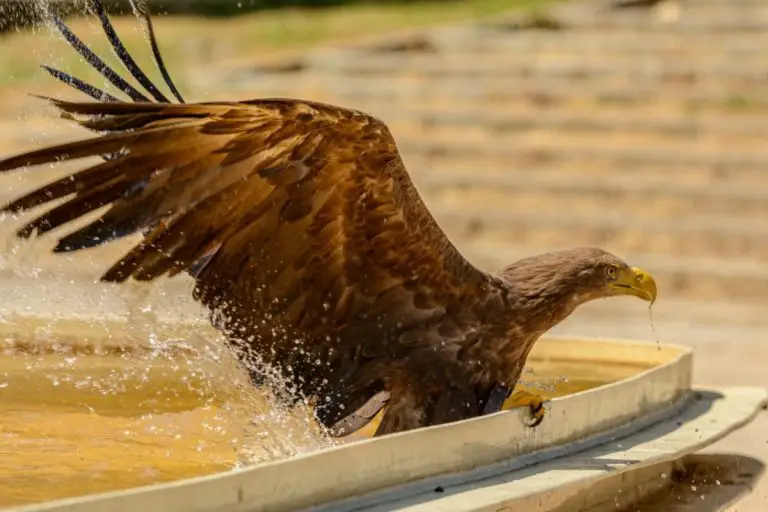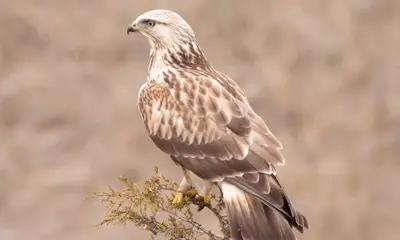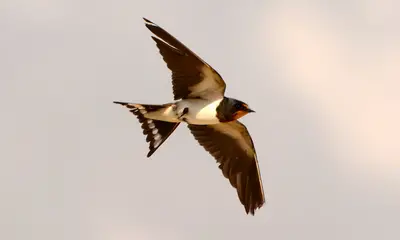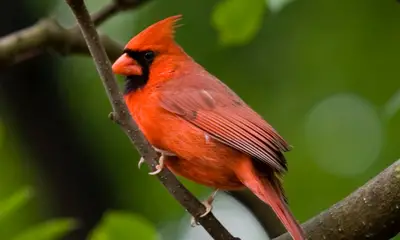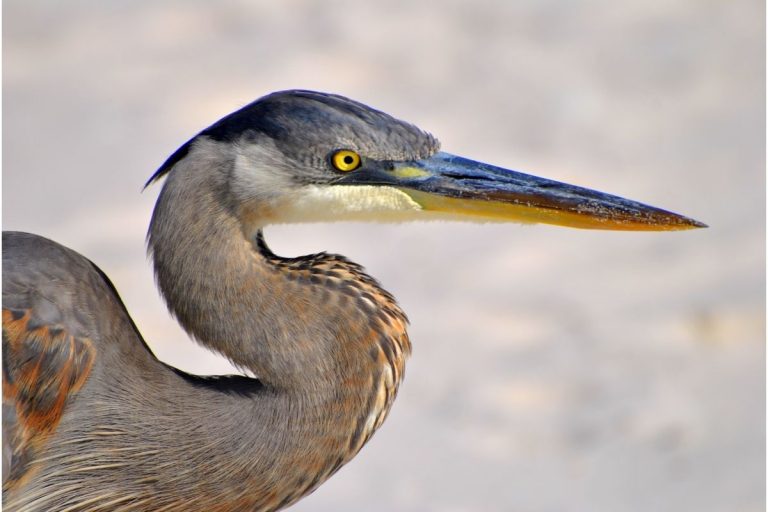29 Types Of BIRDS OF PREY In Arizona (ID Guide With Photos)
Did you recently come across a bird of prey in Arizona, and want to know what species it was?
Identifying birds of prey in the Grand Canyon State is not as easy as it might seem, since there are many raptors that regularly occur in Arizona.
To help you identify the bird you saw, we’ll cover the most common birds of prey of Arizona in this article.

What are the types of birds of prey in Arizona?
The 29 types of birds of prey found in Arizona are:
- Red-tailed Hawk
- Sharp-shinned Hawk
- Cooper’s Hawk
- Northern Goshawk
- Harris’s Hawk
- Swainson’s Hawk
- Rough-legged Hawk
- Common Black Hawk
- Zone-tailed Hawk
- Ferruginous Hawk
- Northern Harrier
- Bald Eagle
- Golden Eagle
- Osprey
- American Kestrel
- Prairie Falcon
- Peregrine Falcon
- Crested Caracara
- Turkey Vulture
- Black Vulture
- Great Horned Owl
- Barn Owl
- Long-eared Owl
- Burrowing Owl
- Short-eared Owl
- Western Screech-Owl
- Spotted Owl
- Northern Pygmy Owl
Note that this list includes both diurnal birds of prey (hawks, eagles, falcons, harriers, and vultures), as well as nocturnal birds of prey (owls).
While many of these birds of prey are found all year in Arizona, a number of them only occur in the state only during the breeding season in summer.
Yet other raptor species are winter visitors to Arizona, and a few are vagrants that only rarely occur in the state.
Now let’s dive into the details, and take a closer look at each of these raptors in Arizona:
Hawks
Red-tailed Hawk
Scientific name: Buteo jamaicensis
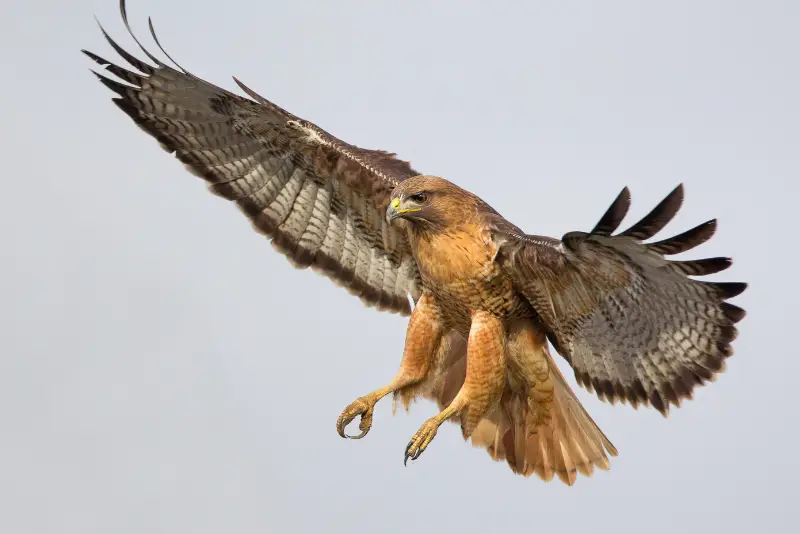
With a wingspan of up to 52 in (4.5 ft), the Red-tailed Hawk is one of the larger species of hawks in Arizona.
It has variable coloration, ranging from dark brown to almost entirely white, but can be readily recognized by its rusty red tail.
This large hawk is common in open grassland and also in cities. It is most often seen perched on roadside posts or fences, waiting for prey.
The Red-tailed Hawk is one of the most common hawk species in Arizona, and can be seen throughout the Grand Canyon State year-round.
This bird of prey feeds on rodents and other small animals that it catches by swooping down from its perch when they venture out into the open.
Sharp-Shinned Hawk
Scientific name: Accipiter striatus
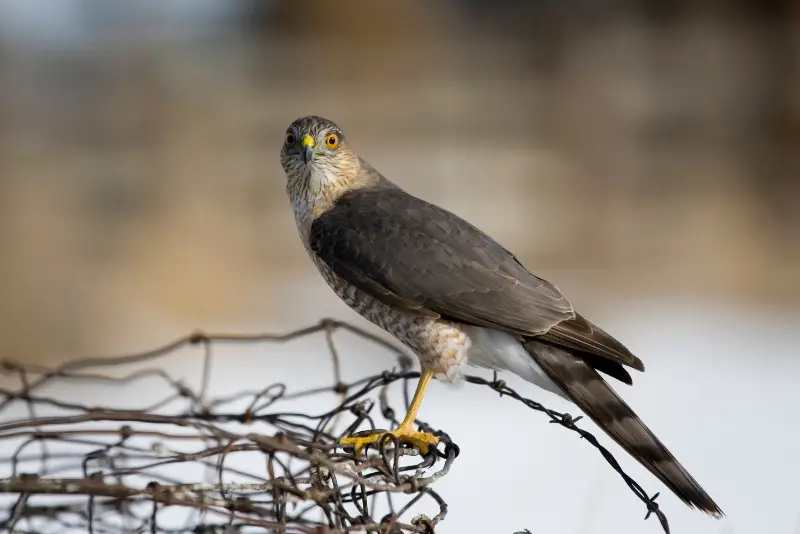
From the largest to the smallest hawk on the list, the sharp-shinned hawk is most commonly seen stalking song birds, making them a regular sight in backyards in the state.
With blue-gray wings and back, and with orange feather patterns on their chests, these hawks are recognizable by their small size, agility, and distinctive behavior.
The breeding range of Sharp-Shinned Hawks is in northern and eastern Arizona, but they can occur throughout the state outside of the breeding season.
Wintering birds are most often Sharp-Shinned Hawks from Canada that spend the cold season in the Great Canyon State.
Cooper’s Hawk
Scientific name: Accipiter cooperii
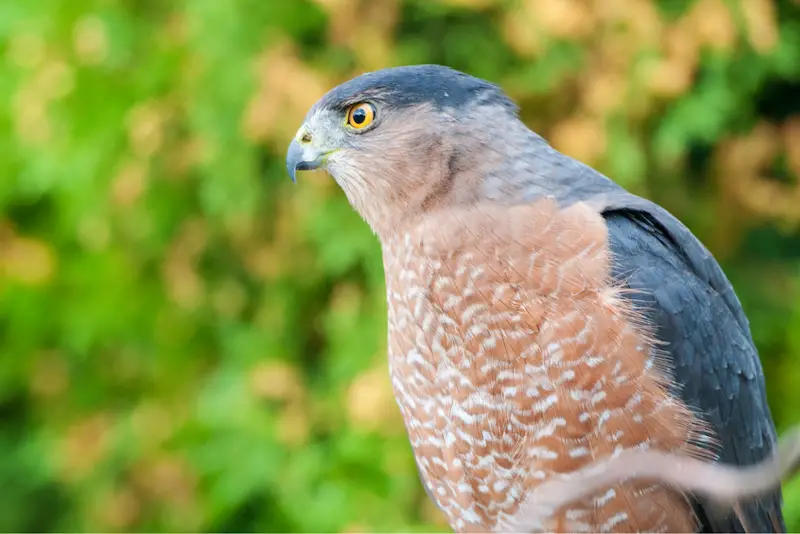
This little Arizona hawk is agile and has a lot of skill when it comes to catching small birds in flight. Sometimes it will even take species that are larger than itself.
Male Cooper’s Hawks have reddish-orange bars on their underside, while their upperparts are grayish-blue. The piercing eyes are vermillion red.
You’re most likely to notice the orange coloration on the chest and underside of a Cooper’s Hawk if you can observe it perched on a branch.
The long tail and small, rounded wings of the Cooper’s Hawk make it possible for these birds of prey to perform sharp turns and quick maneuvers in the thick foliage of dense forests and shrubs.
While Cooper’s Hawks were originally shy woodland raptors, they are now commonly found in urban areas such as Phoenix and Tucson, where they hunt doves and songbirds.
It is not unusual for a Cooper’s Hawk to show up at a bird feeder, where it tries to surprise and ambush feeding songbirds with a lightning fast dash from a hidden perch.
It is a summer visitor in the northern parts of North America, while it can be found year-round in Arizona.
Northern Goshawk
Scientific name: Accipiter gentilis
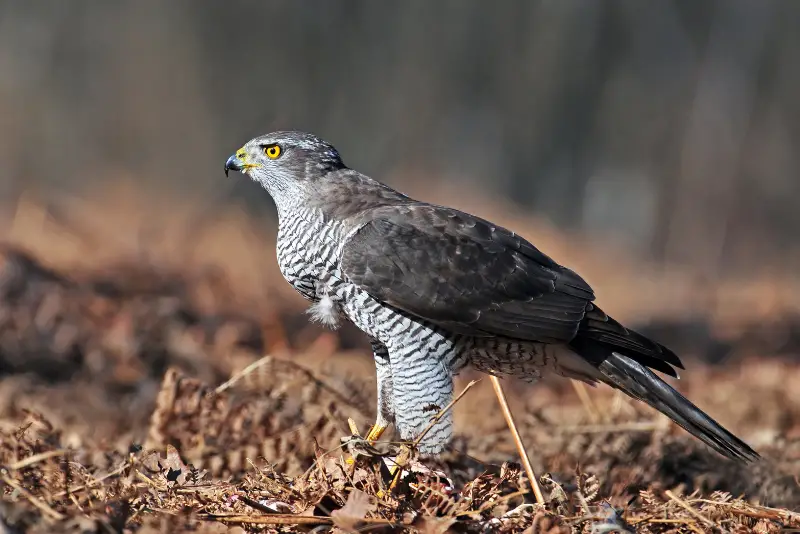
The Northern Goshawk is the largest accipiter hawk in the state of Arizona, and significantly larger than the two Coopers’ and Sharp-shinned Hawks.
It also has slightly longer wings and a more rounded tail, and as a result looks slightly similar to buteo hawks.
However, its behavior is very different from buteo hawks, as it spends much less time soaring or perched in prominent locations.
Instead, the Northern Goshawk hunts by flying at low altitude over open woodland or along forest edges, in order to surprise its prey out in the open.
When this hawk does hunt from a perch, it is usually well hidden, and thus hard to spot.
Northern Goshawks are breeding birds and year-round residents in the eastern half of Arizona, and are found in the rest of the state outside of the breeding season.
Harris’s Hawk
Scientific name: Parabuteo unicinctus
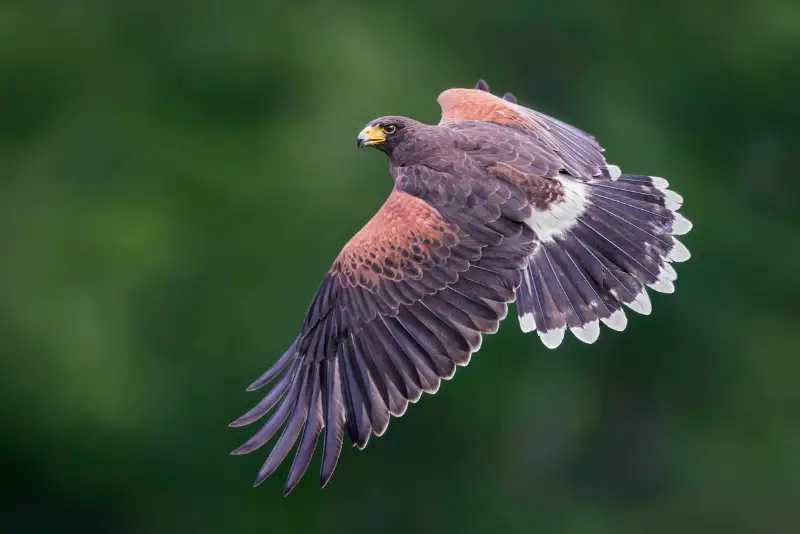
This is a large buteo hawk with a long tail and long legs. It is a dark brown raptor with chestnut patches on its shoulders, as well as on its thighs.
Another great distinguishing feature of the Harris’s Hawk is the white terminal bar at the end of the tail, which is clearly visible when it soars on thermal currents.
These Hawks are most commonly found in Mexico and South America, but also breed in the southernmost part of Arizona.
Unlike most hawk species, the Harris’s Hawk is very social, and often hunts in groups of 3 or more individuals.
Scientists have found that cooperatively hunting hawks are more successful than those that hunt alone.
Swainson’s Hawk
Scientific name: Buteo swainsoni
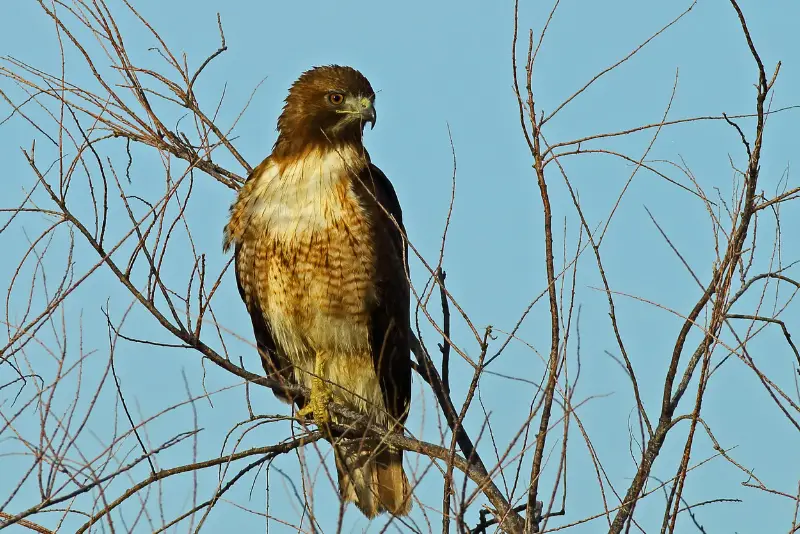
The Swainson’s Hawk is a compact buteo that frequents dry prairies and open areas throughout Arizona during the summer months.
These hawks have long, narrow wings, and are best identified by their brown chest, which contrasts with the white underwings and chin.
Swainson’s Hawks are migratory birds of prey that spend the winter in Argentina.
In fall they gather in flocks numbering in the tens of thousands that migrate south together, often together with other species, such as Broad-winged Hawks.
These common Arizona hawks can be seen in the Grand Canyon State from April through September.
Rough-legged Hawk
Scientific name: Buteo lagopus
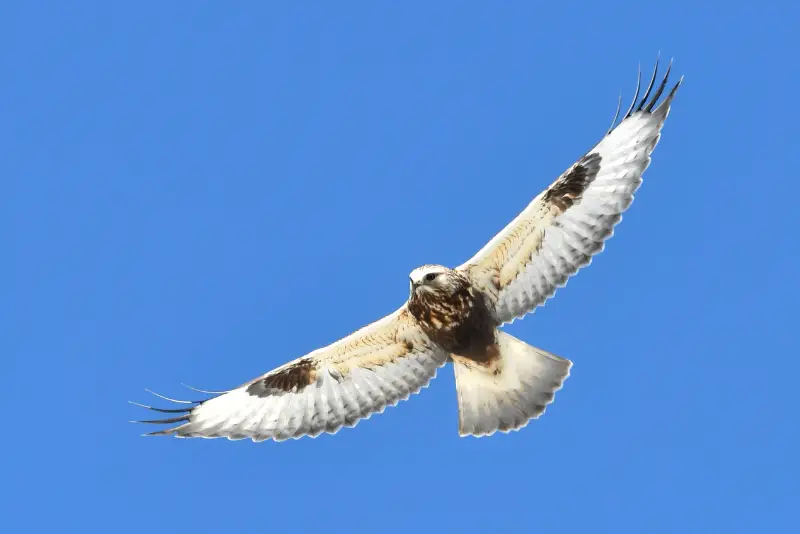
The Rough-legged Hawk is a breeding bird of the arctic tundra in northern Canada and Alaska, but can be seen wintering in large parts of the USA during the cold months.
It can be seen in Arizona from October through March, and favors open habitats such as farmland, pastures and marshland.
Its preferred foraging tactic is to hunt from a perch, such as a fence post or telephone pole, though it also hovers on occasion, similar to a kestrel.
This is a large buteo hawk that is best identified by its dark brown belly, which contrasts with the white underside of its wings and tail.
Common Black Hawk
Scientific name: Buteogallus anthracinus
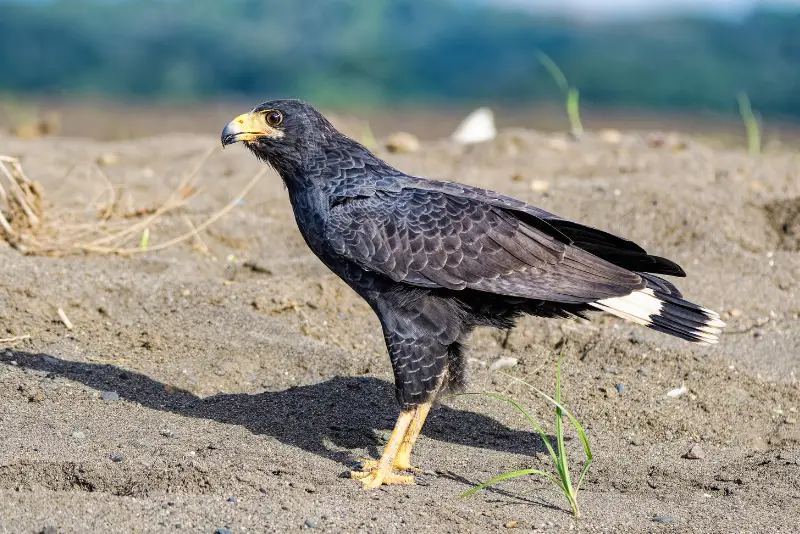
This is a large hawk with broad wings and a relatively short tail. It is best identified by its soot black color which contrasts with a white band on the base of its tail.
Common Black Hawks are most commonly found in Mexico and Central America, but also have a breeding population in south Arizona.
They frequent canyons with wooded streams, where they primarily hunt fish, amphibians, and rodents that live in and around water.
These raptors migrate south in September, to spend the winter in Mexico. In Central America, they are most often found in swamps and marshy areas.
Zone-tailed Hawk
Scientific name: Buteo albonotatus
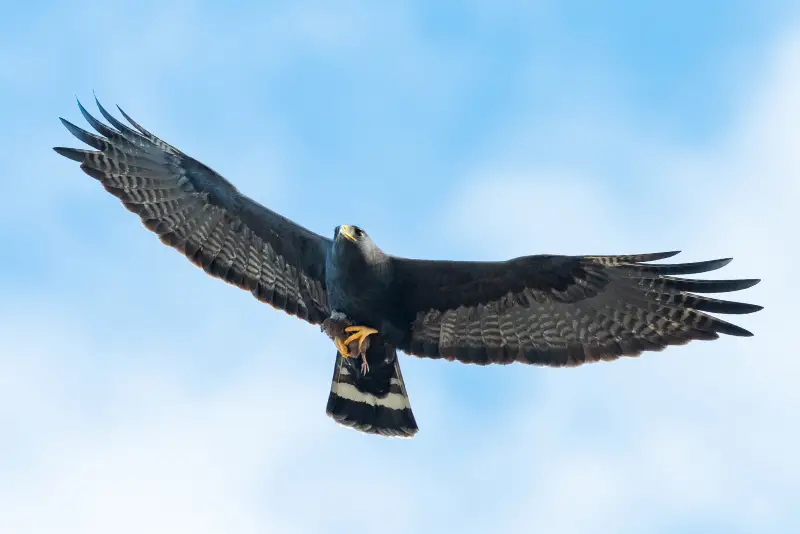
The Zone-tailed Hawk is another migratory hawk species found in southeastern Arizona during the breeding season in summer.
These hawks are almost black, except for light barred areas on their flight and tail feathers.
Interestingly, they resemble Turkey Vultures both in their overall appearance and in their behavior.
Ornithologists believe that this similarity is not an accident, and that Zone-tailed Hawks use it to their advantage, as most of their prey species see Turkey Vultures as harmless.
They favor arid cliffs, canyons and foothills, where they hunt small mammals, reptiles and birds.
Ferruginous Hawk
Scientific name: Buteo regalis
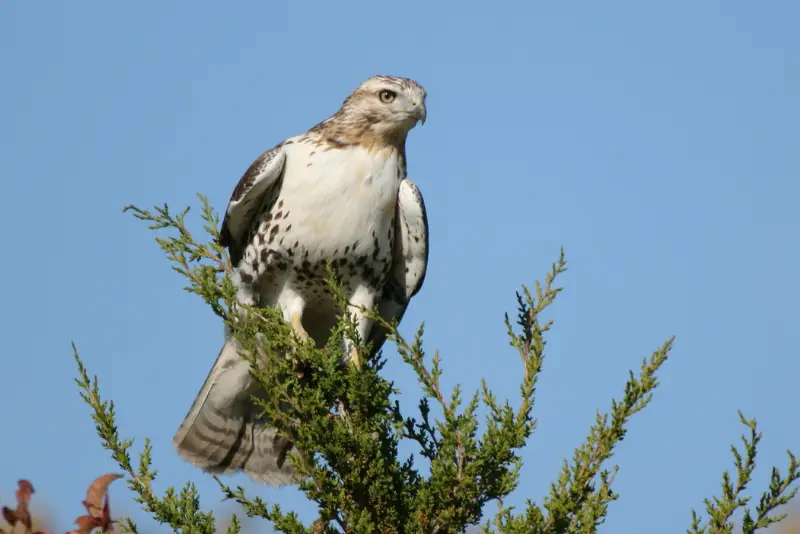
The Ferruginous Hawk is a very large buteo hawk of the western prairies and deserts. With a wingspan of up to 56 inches, it is the largest hawk in Arizona.
This hawk is a breeding bird in northern Arizona, and is found throughout the state outside of the breeding season.
While it occurs in two color morphs (light and dark), the more common of these is the light morph.
The light morph is easily identifiable by its bright white underside, gray head, and rusty brown upperparts.
These hawks feed on rodents and other small mammals, with prairie dogs forming a large part of their diet.
Harriers
Northern Harrier
Scientific name: Circus hudsonius
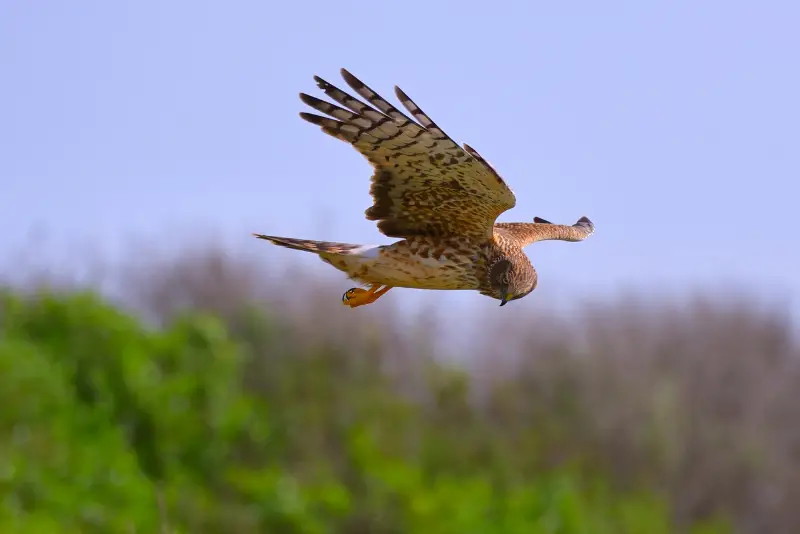
The Northern Harrier is a breeding bird of the northern parts of North America, but spends the winter in the southern USA and Central America.
This harrier is a winter bird in Arizona from October through April, where it frequents open grassland and marshes.
Harriers are most easily identified by their behavior. Their foraging tactic is to fly slowly just a few feet above the ground, in order to pounce on any rodent caught outside its burrow.
Eagles
Bald Eagle
Scientific name: Haliaeetus leucocephalus
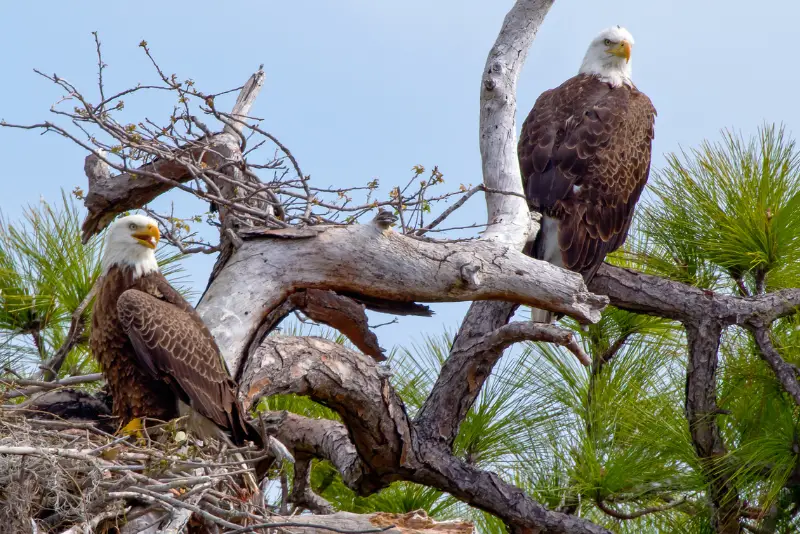
With a wingspan of up to 8 feet, the Bald Eagle is a huge raptor, and impossible to miss if you spot this eagle soaring in the Great Canyon State.
Apart from its size, the Bald Eagle is also one of the most easily recognizable birds in Arizona, due to its white head and tail, which contrast sharply with the uniformly dark brown body.
Juvenile Bald Eagles are dark brown all over, with light irregular streaks all over the body, as well as a buff white belly.
This huge bird of prey is a breeding bird in central Arizona, and is also found in other parts of the state outside of the breeding season.
Bald Eagles spend a lot of their time soaring on thermal currents with their wings held flat. They feed on fish, birds, and small mammals, although a big part of their diet consists of carrion.
Golden Eagle
Scientific name: Aquila chrysaetos
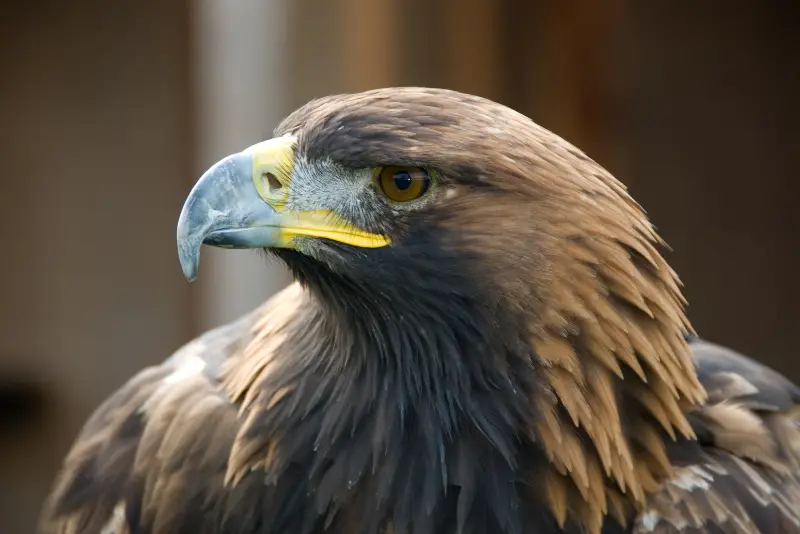
The Golden Eagle is one the most impressive eagle species in North America, and is a breeding bird in western states of the USA.
In Arizona, the Golden Eagle is a regular breeding bird in many parts of the state, and can be observed all year round.
Golden Eagles can be distinguished from Bald Eagles by their lack of white coloration on their heads.
The Golden Eagle is one of several circumpolar raptor species, and can be found in both the New World and the Old World.
Osprey
Scientific name: Pandion haliaetus

While the Osprey is technically not an eagle, it has a wingspan of up to 69 in (5.5 ft), and resembles an eagle in size.
It is usually easy to identify the Osprey due white belly and chest, which contrast with its blackish gray upperparts and black wrist patches on its lower wings.
This large Arizona bird is the only raptor species that plunges into water in order to catch fish, often becoming entirely submerged in the water as it attempts to grab a fish with its feet.
Due to this style of hunting, Ospreys are almost always found close to water, except during migration, when they will cross areas without water.
The Osprey is a rare breeding bird in central Arizona, but also occurs as a winter bird in southern Arizona.
Falcons
American Kestrel
Scientific name: Falco sparverius
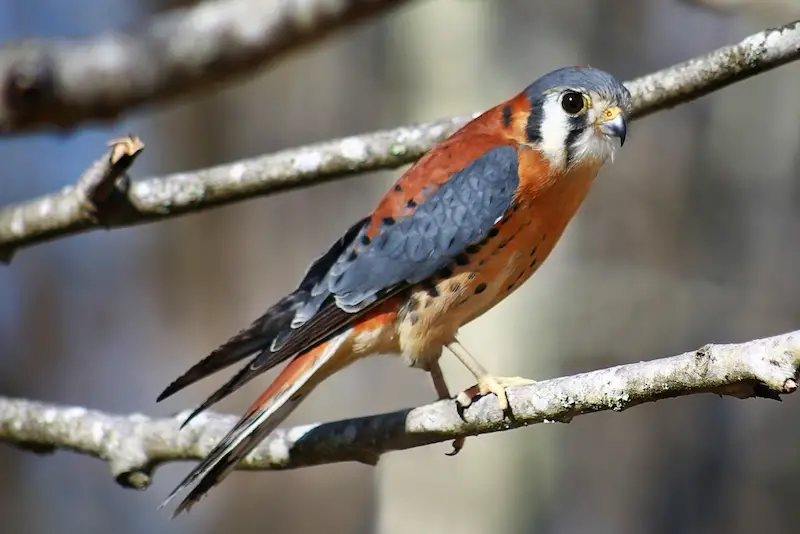
The American Kestrel is not only the smallest falcon in North America, but also one of the most common raptors.
Male American Kestrels are very colorful, and sport rufous orange upperparts and and tail, as well as blue gray wings with dark pointed tips.
The male also has a reddish orange cap on its crown, as well as a dark mustache and dark bar behind the eye.
Female American Kestrels are more pale in their coloration, but also have rufous orange upperparts.
When foraging for food, it likes to hover over fields and meadows, or hunt from a perch such as a telephone pole or tree branch.
After it spots a rodent or other small animal, the American Kestrel dives down to grab it with its talons.
The most commonly taken prey during the spring and summer months are insects and worms, while rodents and small birds predominate during the colder months.
It likes to nest in abandoned Woodpecker holes, as well as crevices in buildings. Also accepts nesting boxes installed by humans.
The American Kestrel is a migratory raptor in the northern parts of its range, while it is a year-round resident in more southern parts. In Arizona, it is a year-round resident.
Prairie Falcon
Scientific name: Falco mexicanus
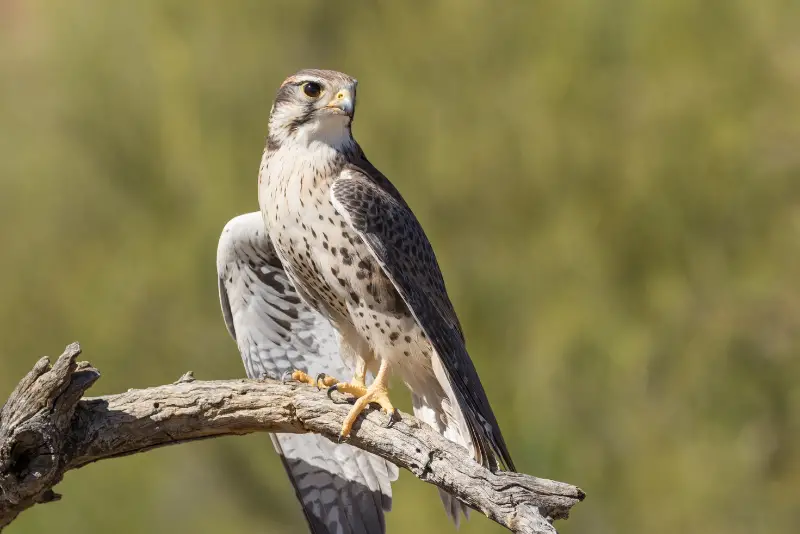
Residing in the open spaces of Arizona, Prairie falcons usually employ low altitude hunting tactics to surprise potential prey on the ground.
They cruise at low altitude over open prairie and grassland, in order to pounce on small birds and mammals they surprise on the ground.
Despite being their size and being quite common in Arizona, the brown coloring of Prairie Falcons tends to make them hard to spot in the wild – a fact that ultimately works in their favor.
Peregrine Falcon
Scientific name: Falco peregrinus
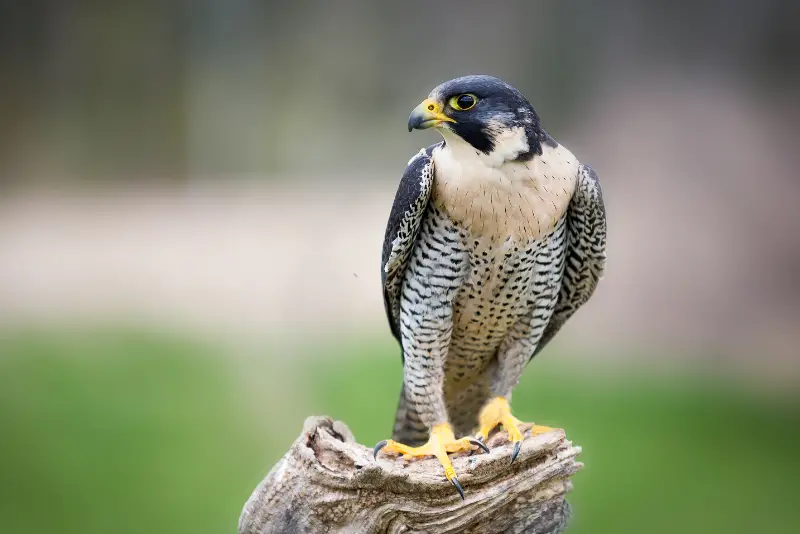
The Peregrine Falcon is the fastest animal in the world. Unbelievably, this falcon can dive from the sky at speeds reaching more than 200 mph.
This makes it perhaps the most accomplished Arizona raptor on this list.
However, unlike Prairie Falcons, Peregrine Falcons feed almost exclusively on birds.
This dietary preference made them highly susceptible to the eggshell-thinning effects of the pesticide DDT, leading to a catastrophic population decline of peregrines in the 1960s and 70s.
But since DDT was made illegal, the Peregrine Falcon population has recovered from its previous decline, and this beautiful raptor is once again a common sight in Arizona.
Crested Caracara
Scientific name: Caracara plancus
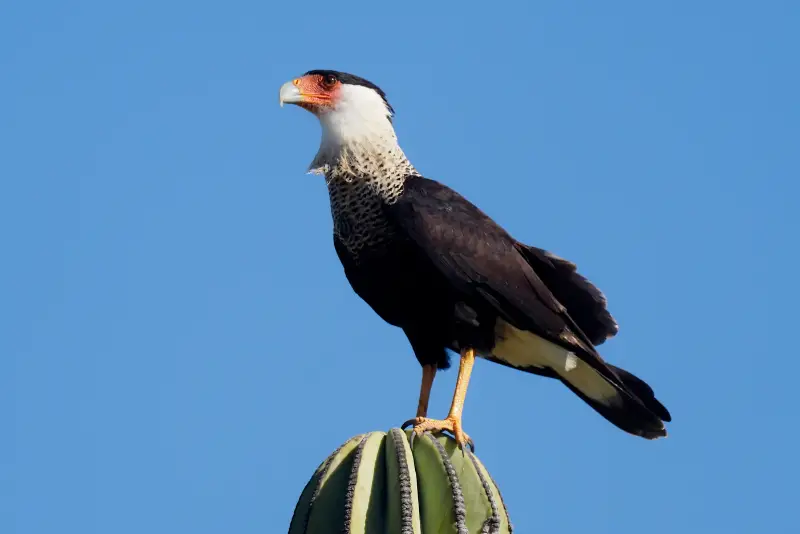
While caracaras belong in the falcon family, they have a very distinctive appearance, due to their large bill and long legs, and their habit of regularly walking on the ground.
Crested Caracaras occur in southern Arizona as rare breeding birds close to the southern border, but their numbers have recently been increasing.
Similar to vultures, these raptors often feed on carcasses. They are most often observed perched on a tall tree, or flying low over the ground.
Vultures
Turkey Vulture
Scientific name: Cathartes aura
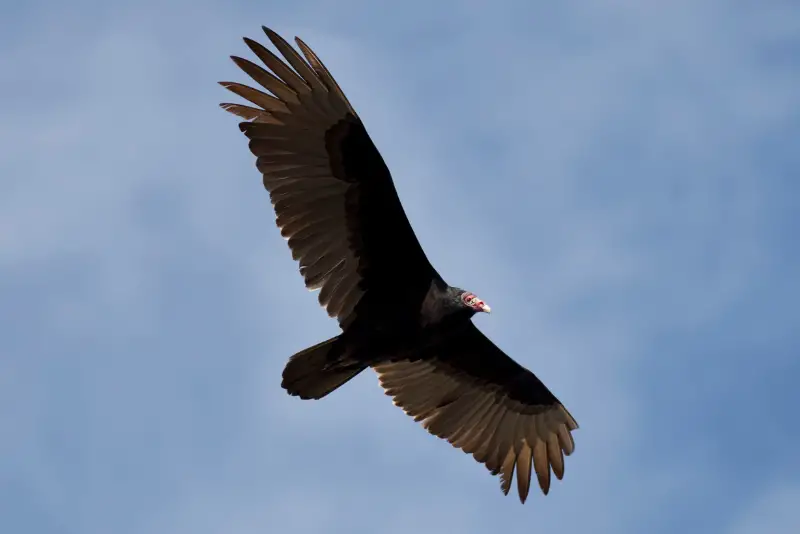
The Turkey Vulture is the largest vulture species breeding in Arizona, and can reach a wingspan of up to 6 feet.
It is a big black raptor with a red head, and dark gray rear margins on their wings, which can be seen in flight.
A soaring Turkey Vulture is easily identifiable due to the fact that it holds its wings in an upright V shape, and has light wingtips.
This big raptor is a summer visitor and breeding bird in Arizona, where it favors open country interspersed with woodland.
Similar to other vulture species, this raptor is specialized in feeding on carrion, and will often congregate in flocks around roadkill.
While Turkey Vultures look superficially similar to Black Vultures, the latter are only rarely observed in Arizona.
Black Vulture
Scientific name: Coragyps atratus
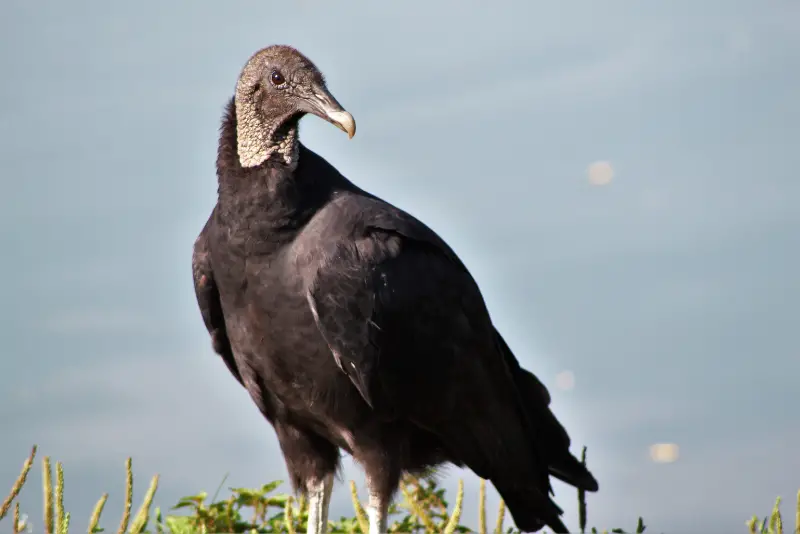
Black Vultures are common in Mexico and southeastern states, and they occur in Arizona only as rare vagrants that cross over from south of the border.
Black Vultures are almost entirely black, except for white wing tips that can be seen from below. They have a naked head with wrinkled, dark skin.
The Black Vultures that show up in Arizona are usually immature birds, as adult pairs remain in their breeding territories year-round.
In contrast to Turkey Vultures, Black Vultures don’t have a keen sense of smell. Because of this, they often use Turkey Vultures as “scouts” to find roadkill, and then intimidate the smaller vulture species to chase away from the carrion.
Related: Types of black birds in Arizona
Owls
Great Horned Owl
Scientific name: Bubo virginianus

With a wingspan up to 4 feet, the Great Horned Owl is the largest owl species breeding in Michigan.
It is a large brown-colored bird with two ear tufts (also called horns) and big yellow eyes.
In Arizona, this owl starts its nesting very early in the year, laying its eggs in January or February.
It is almost entirely nocturnal, and can hunt in complete darkness by relying on its keen sense of hearing.
The Great Horned Owl doesn’t build its own nest, but instead occupies the nests of other large birds, such as Arizona herons or raptors.
It is found year-round throughout Arizona, and can be found in a wide variety of habitats in Michigan, from woodlands to urban areas.
This owl is a fierce hunter, catching birds up to the size of ducks, and mammals up to the size of squirrels, rabbits, and even young foxes.
Barn Owl
Scientific name: Tyto alba
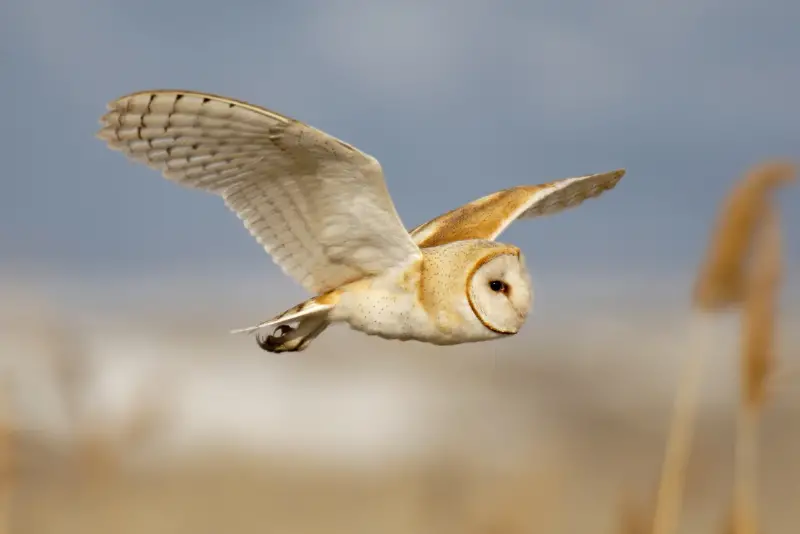
Somewhat softer and less intense-looking than the Great Horned Owl, Barn Owls are characterized by their white coat of feathers, and their “friendlier” appearance.
Armed with exceptional night vision, Barn Owls are strictly nocturnal raptors and therefore hard to spot. However, they can be readily identified by their characteristic screeching calls.
And if you do spot one flying overhead by the light of the moon, you may be able to see the glow of their white underside.
These owls are present in Arizona all year round, and favor open areas and farmland as their hunting grounds.
Long-eared Owl
Scientific name: Asio otus
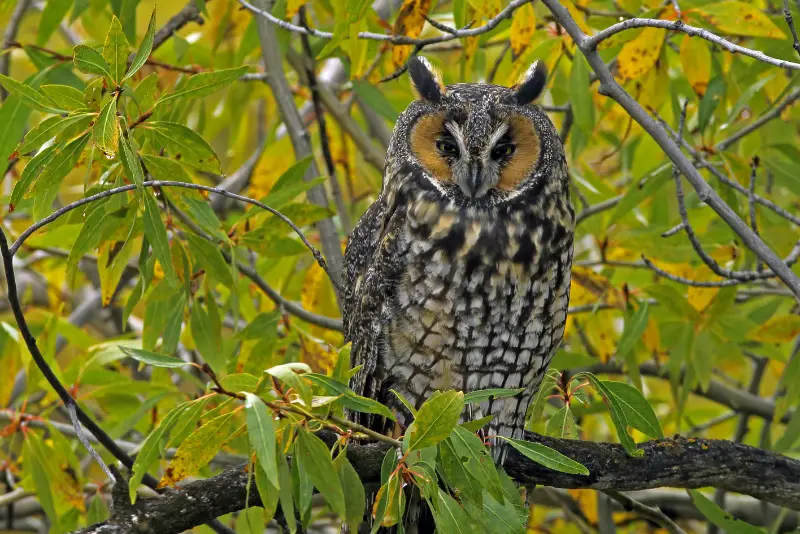
These well-camouflaged, elusive owls are smaller than the aforementioned species.
They use their favored habitat of dense wooded areas to prey on the small rodents and animals that call the nearby grasslands their home.
Similar to other owl species, Long-eared Owls can fly completely silently due to fringes on their flight feathers.
Together with their keen sense of hearing, this enables them to catch prey by surprising it in the dark of the night.
But despite their best efforts to remain hidden, these commonly found Arizona owls can be identified by their long, low hoots.
Another great characteristic for identifying these owls is by their elongated tufts of feathers on the ears, and their droppings found underneath conifer trees close to grassy areas.
Burrowing Owl
Scientific name: Athene cunicularia
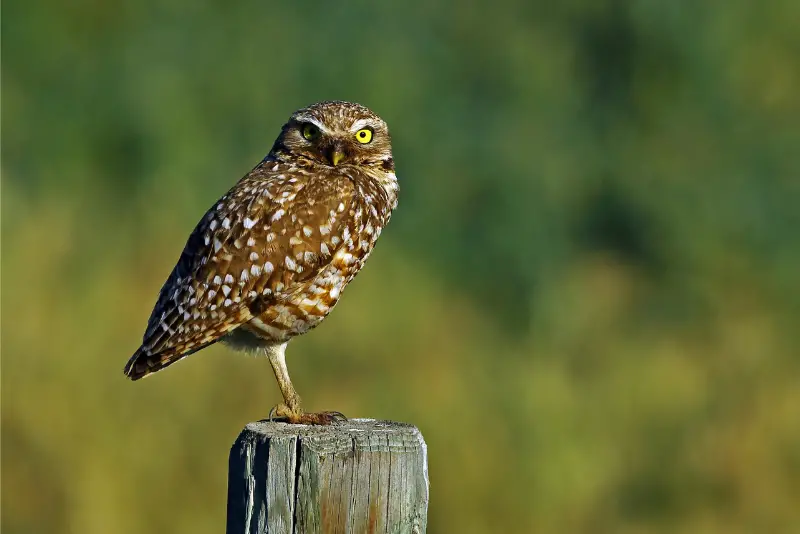
The Burrowing Owl is a scarce resident of open areas in Arizona. It digs its own burrows, but also often takes over burrows from prairie dogs or ground squirrels.
This owl is active both day and night, and hunts insects and small rodents in open areas.
Due to their small size, these Arizona owls can be hard to spot in the expanse of open prairies.
They are most often observed perching on a small mound, from where they can scan their surroundings in search of food.
Short-eared Owl
Scientific name: Asio flammeus

The Short-eared Owl is a highly migratory owl species, and while it doesn’t breed in Arizona, it is regularly observed in the state outside of the breeding season.
Short-eared Owls are more often observed hunting in daylight than other owls species.
Together with their hunting tactic of flying low over the ground in open areas, this makes them relatively easy to spot.
You can encounter these owls in Arizona in any kind of open landscapes, including farmland, airports, and fallow land.
Western Screech-Owl
Scientific name: Megascops kennicottii
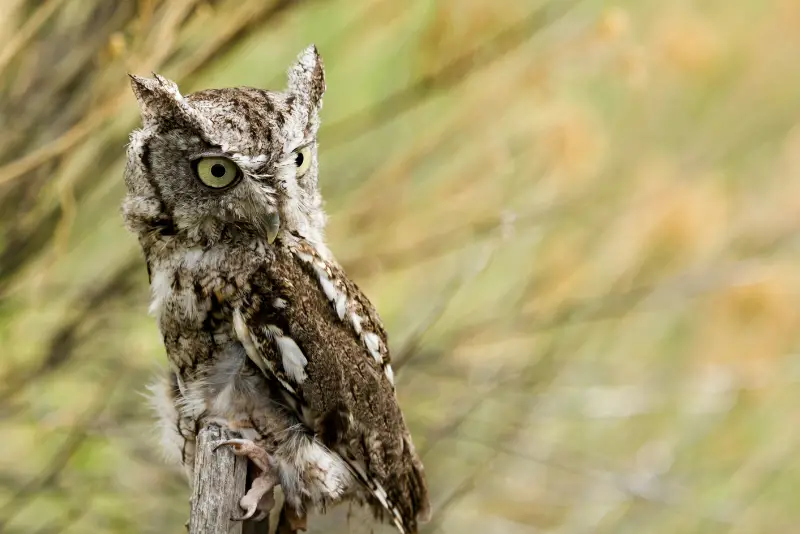
Originally birds of open woodlands, Western Screech-Owls have adapted very well to urban habitats, and are regularly found in parks, large gardens, and golf courses.
They breed in tree cavities, and are best identified by their characteristic series of accelerating hoots.
These Arizona owls are common throughout Arizona and can be seen all year round. They have a very varied diet, which includes any type of small animal ranging from worms to insects and rodents.
Western Screech-Owls readily accept artificial nesting cavities, which means you can attract them to your backyard by setting up nest boxes.
Spotted Owl
Scientific name: Strix occidentalis
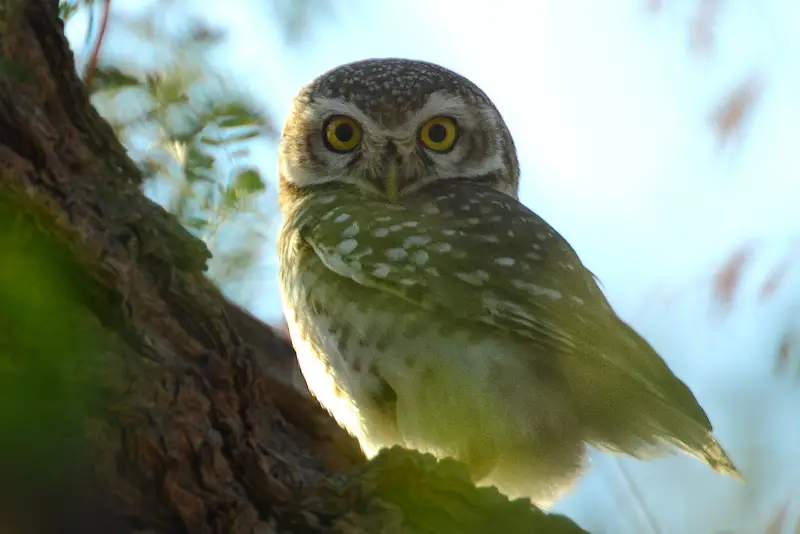
These owls have become increasingly rare, since their preferred habitat is mature forest, which has been steadily declining across its range in North America.
Arizona is home to the Mexican Spotted Owl, which is one of three subspecies of the Spotted Owl in North America.
This owl has a very patchy distribution in the Grand Canyon State, which makes it difficult to find. Similar to other owl species, the best way to identify these owls is by their hooting calls.
Similar to other owls, it feeds on small mammals, but likes to specialize on flying squirrels and woodrats.
Northern Pygmy Owl
Scientific name: Glaucidium gnoma
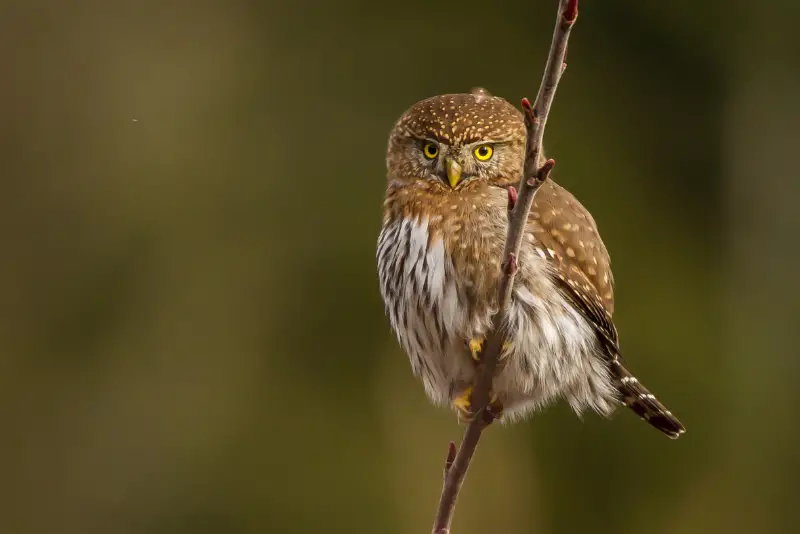
The Northern Pygmy Owl is the smallest owl found in Arizona. But while it may be tiny, it is an aggressive hunter that regularly catches songbirds as large as itself.
This owl likes to hunt during the day. It perches in a hidden spot, and dashes out if a songbird should venture close to it.
When songbirds spot a Pygmy Owl, they will gang up on and mob the owl until it gives up and flies away.
Since Northern Pygmy Owls are usually hard to spot, the best way to find them is by paying attention to mobbing songbirds, and use them as your guide.
Conclusion
And there we have the most commonly found raptors in Arizona.
The arid expanse of Arizona is home to more than 400 different species of birds, and birds of prey make up a significant proportion of this rich avifauna.
Ranging from hawks to eagles, vultures, falcons, and owls, these birds of prey play a vital role as apex predators.
Raptors are paramount to maintaining balanced rodent and small wildlife populations, as well as helping to dispose of animal carcasses with scavenging.
If you enjoyed this article, check out our guide to the yellow birds in Arizona.

